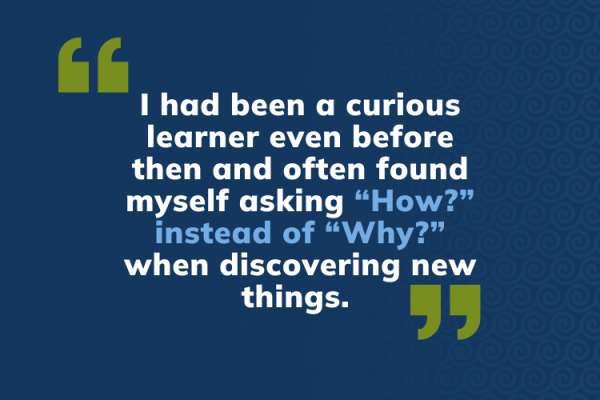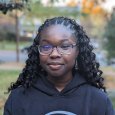My STEM journey started in 6th grade, during a quiz when my science teacher slipped me a folded blue sheet of paper and told me not to open it until later. That day at lunch, I unfolded the mysterious note under the table and stared in surprise at the bold letters on the page. It was a flier for a countywide science fair.
In truth, my journey had started long before that, but this was the moment that the first, rickety wooden step became concrete.

Be it a doorknob, a clock, or a cotton candy machine, I have always wanted to understand the inner workings of an object. Presented with the opportunity to finally create something of my own, I was thrust into a world of discovery that I never planned on leaving.
My success at the competition is what initially drew me to engineering. I realized that, as much as I loved learning, I wanted to create things. Applying my newly obtained knowledge to real-world problems through tangible inventions is where I have always felt happiest, even when my expertise was limited to sixth-grade-level science projects.
This journey underscored the critical role of youth in shaping the future of STEM. Young minds, though impressionable, offer curiosity and unfiltered perspectives that are invaluable to the problem-solving that will take place in the near future. In order to prepare the world for this, it is crucial to foster a culture of empowerment among youth, encouraging them to explore their STEM passions. My story, along with many others, is a testament to the potential that exists when young people are given the opportunity to dream. It inspires us to invest in STEM education and to provide platforms for young voices to be heard, ensuring a future where innovation knows no bounds.
However, despite significant leaps made in youth inclusion in STEM in recent years, gender inequality is a persisting issue. Between 2017 and 2018, The Universities and Colleges Admissions Service reported that only 19% of students studying computer sciences related degrees were female. This statistic is informed by the stereotypes, lack of female representation, and unequal opportunities that are fed to female students in their youth. These challenges create barriers for girls and young women interested in STEM careers and create a cycle of hindered progress.
Naturally, youth advocates play a pivotal role in counteracting these obstacles. As role models, we have the ability to challenge stereotypes, advocate for equitable policies, and raise awareness, ultimately creating a more inclusive culture surrounding STEM. Our efforts, whether through the Youth Advisory Board, the classroom, or solo volunteer work, contribute to building supportive networks of girls at all levels of STEM education.
A specific initiative I have been involved in to effectively support girls in STEM is participating in my school’s chapter of Women in STEM (WiSTEM), an international organization that bridges the gap between social justice and academic fields. Through our school club, I have tutored young girls in science and math and led discussions on the unique perspectives that women bring to the STEM world. While my goal is to mentor and inspire young girls who share my background, the experience has been teaching for me as well.
I am also an active member of NGCP’s Youth Advisory Board, an experience that has bolstered my confidence in my ability to advocate for myself and others. Outside of presenting me with countless opportunities for growth and networking, NGCP has introduced me to a group of talented, like-minded peers that I am inspired by during every single one of our meetings. Our monthly discussions are always enlightening, informed by the diverse perspectives that make up our board.
A specific experience that comes to mind is our recent Cyber-Rights town hall, which was hosted by me and moderated by NGCP Board Member Sandra Yang.

The session featured Microsoft’s Laurie Kirk and Anne Etienne. I thought it was very successful because both panelists shared powerful insights ranging from their career focuses to their specific motivations for pursuing STEM. Overall, the zoom was very successful and contributed to reinforcing the rhetoric that women can be leaders in STEM.
Regardless, the widespread underrepresentation of women in STEM fields remains a persistent challenge. From subtle biases to blatant systemic discrimination against women, there are barriers at each level of progress that girls and women make. As such, change needs to be made at every stage. As much as young girls should be taught and encouraged to pursue STEM and advocate for themselves, educators must learn to challenge their inherent biases and create inclusive learning environments. Mentors and role models should be readily available to anyone who needs them, and men need to be made aware of the privilege they hold.
In the future, I imagine myself contributing to this mission by not only continuing my current volunteer work, but also challenging myself career-wise and academically so that I may serve as a role model. While one person may not seem like enough to alter a statistic, the collective impact of countless girls can.
To this point, I want to close by saying: Every young person has the power to make a real difference in STEM and the world at large. If we all chose to embrace our passions, it would shape a much brighter future. Your voice matters in whatever capacity you choose to use it. I encourage everyone reading this post to help me create a world where access to and inclusions in STEM are the name.
To youth interested in advocating for gender equity and supporting girls in STEM, look into NGCP’s current initiatives to find opportunities that align with your interests.

Audrey O.
Audrey is a high school junior in Silver Spring, Maryland who has always wanted to pursue a career in STEM. At her school, she is enrolled in the IB Diploma Programme and is a Peer Writing Center consultant. Academically, Audrey is interested in math and outer space and hopes to pursue a career in scientific research and engineering. She is also very passionate about educational equity in STEM fields and has worked to increase it by leading a chapter of the National Society of Black Engineers, tutoring, writing for an international STEM magazine, and volunteering at a local interactive STEM Museum.
Outside of STEM, Audrey enjoys travel and learning languages, currently studying Portuguese, Mandarin, and Twi. She hopes to study abroad and explore an interdisciplinary major in university that combines technology and machine design with human sciences. She is also a rising figure skater and hopes to begin competing in the sport when she goes to college. Overall, Audrey is grateful for this opportunity and incredibly excited to contribute to the YAB with ideas for introducing STEM to young girls nationwide.